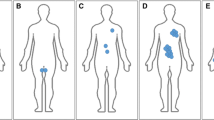Abstract
Purpose
To investigate the influence of amplicons size and cell type on allele dropout and amplification failures in single-cell based molecular diagnosis.
Methods
730 single lymphocytes and amniotic cells were collected from known heterozygotes individuals to one of the common Ashkenazi Jewish mutations: 1278+TATC and IVS12+1G>C which cause Tay Sachs Disease, IVS20+6T and 854A>C which underlie Familial Dysautonomia and Canavan Disease. DNA was extracted and analyzed by our routine methods.
Results
Reduced rates of allele dropout and amplification failure were found when smaller amplification product were designed and in amniotic cultured cells compared to peripheral lymphocytes. Cultured lymphocytes, induced to divide, demonstrated significantly less allele dropout than non induced lymphocytes suggesting the role of division potential on amplification efficiency.
Conclusion
Single cell based diagnosis should be designed for each mutation. Minimal sized amplicons and cell having division potential should be preferred, as well as sensitive techniques to detect preferential amplification.

Similar content being viewed by others
References
Handyside AH, Pattinson JK, Penketh RJ, Delhanty JD, Winston RM, Tuddenham EG. Biopsy of human preimplantation embryos and sexing by DNA amplification. Lancet. 1989;1:347–9.
Wells D, Sherlock JK. Strategies for preimplantation genetic diagnosis of single gene disorders by DNA amplification. Prenat Diagn. 1998;18:1389–401.
Braude P, Pickering S, Flinter F, Ogilvie CM. Preimplantation genetic diagnosis. Nat Rev Genet. 2002;3:941–53.
Bick DP, Lau EC. Preimplantation genetic diagnosis. Pediatr Clin North Am. 2006;53:559–77.
Goossens V, Harton G, Moutou C, Scriven PN, Traeger-Synodinos J, Sermon K, et al. ESHRE PGD Consortium data collection VIII: cycles from January to December 2005 with pregnancy follow-up to October 2006. Hum Reprod. 2008;1-5
Harper JC, de Die-Smulders C, Goossens V, Harton G, Moutou C, Repping S, et al. ESHRE PGD consortium data collection VII: cycles from January to December 2004 with pregnancy follow-up to October 2005. Hum Reprod. 2008;23:741–55.
Sermon K, De Rycke M. Single cell polymerase chain reaction for preimplantation genetic diagnosis: methods, strategies, and limitations. Methods Mol Biol. 2007;132:31–42.
Ray PF, Ao A, Taylor DM, Winston RM, Handyside AH. Assessment of the reliability of single blastomere analysis for preimplantation diagnosis of the delta F508 deletion causing cystic fibrosis in clinical practice. Prenat Diagn. 1998;18:1402–12.
Piyamongkol W, Bermudez MG, Harper JC, Wells D. Detailed investigation of factors influencing amplification efficiency and allele drop-out in single cell PCR: implications for preimplantation genetic diagnosis. Mol Hum Reprod. 2003;9:411–20.
Findlay I, Ray P, Quirke P, Rutherford A, Lilford R. Allelic drop-out and preferential amplification in single cells and human blastomeres: implications for preimplantation diagnosis of sex and cystic fibrosis. Hum Reprod. 1995;10:1609–18.
Rechitsky S, Strom C, Verlinsky O, Amet T, Ivakhnenko V, Kukharenko V, et al. Allele dropout in polar bodies and blastomeres. J Assist Reprod Genet. 1998;15:253–7.
Dreesen JC, Bras M, Coonen E, Dumoulin JC, Evers JL, Geraedts JP. Allelic dropout caused by allele-specific amplification failure in single-cell PCR of the cystic fibrosis delta F508 deletion. J Assist Reprod Genet. 1996;13:112–4.
Gitlin SA, Lanzendorf SE, Gibbons WE. Polymerase chain reaction amplification specificity: incidence of allele dropout using different DNA preparation methods for heterozygous single cells. J Assist Reprod Genet. 1996;13:107–11.
Kim SA, Yoon JA, Kang MJ, Choi YM, Chae SJ, Moon SY. An efficient and reliable DNA extraction method for preimplantation genetic diagnosis: a comparison of allele drop out and amplification rates using different single cell lysis methods. Fertil Steril. 2009;92:814–8.
Lamvik JO. Separation of lymphocytes from human blood. Acta Haematol. 1996;35:294–303.
Sermon K, Lissen W, Nagy ZP, Van Steirteghem, Liebaers I. Simultaneous amplification of the two most frequent mutations of infantile Tay-Sachs disease in single blastomers. Hum Reprod. 1995;10:2214–7.
Ruano G, Kidd KK. Modeling of heteroduplex formation during PCR from mixture of DNA templates. PCR Methods Appl. 1992;2:112–6.
Myerwitz R. Splice junction mutation in some Ashkenazi Jews with Tay-Sachs disease: evidence against a single defect within the ethnic group. Proc Natl Acad Sci USA. 1988;85:3955–9.
Matalon R, Michals K, Gashkoff P, Kaul R. Prenatal diagnosis of Canavan disease. J Inherit Metab Dis. 1992;15:392–4.
Dong J, Edelmann L, Bajwa AM, Kornreich R, Desnick RJ. Familial dysautonomia: detection of the IKBKAP IVS20+6T>C and R696P mutations and frequencing among Ashkenazi Jews. Am J Med Genet. 2002;110:253–7.
Ray PF, Handyside AH. Increasing the denaturation temperature during the first cycles of amplification reduces allele dropout from single cells for preimplantation genetic diagnosis. Mol Hum Reprod. 1996;2:213–8.
El-Hashemite N, Delhanty JD. A technique for eliminating allele specific amplification failure during DNA amplification of heterozygous cells for preimplantation diagnosis. Mol Hum Reprod. 1997;3:975–8.
Handyside AH. Clinical evaluation of preimplantation genetic diagnosis. Prenat Diagn. 1998;18:1345–8.
Thornhill AR, Snow K. Molecular diagnostics in preimplantation genetic diagnosis. J Mol Diagnostics. 2002;4:11–29.
Verlinsky Y, Kuliev A. Preimplantation polar body diagnosis. Biochem Mol Med. 1996;58:13–7.
Findlay I, Matthews P, Quirke P. Multiple genetic diagnoses from single cells using multiplex PCR: reliability and allele dropout. Prenat Diagn. 1998;18:1413–21.
Kuo HC, Ogilvie CM, Handyside AH. Chromosomal mosaicism in cleavage-stage human embryos and accuracy of single-cell genetic analysis. J Assist Reprod Genet. 1998;15:276–80.
Author information
Authors and Affiliations
Corresponding author
Additional information
Capsule
Allele dropout rate in single cell based diagnosis requires careful adjustment concerning cell type, division potential and PCR fragment size that significantly affect the system.
Rights and permissions
About this article
Cite this article
Dotan, K., Feldman, B., Goldman, B. et al. The single cell as a tool for genetic testing: credibility, precision, implication. J Assist Reprod Genet 27, 335–341 (2010). https://doi.org/10.1007/s10815-010-9396-5
Received:
Accepted:
Published:
Issue Date:
DOI: https://doi.org/10.1007/s10815-010-9396-5




